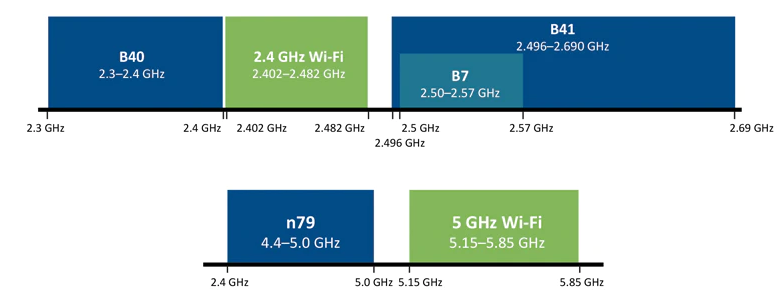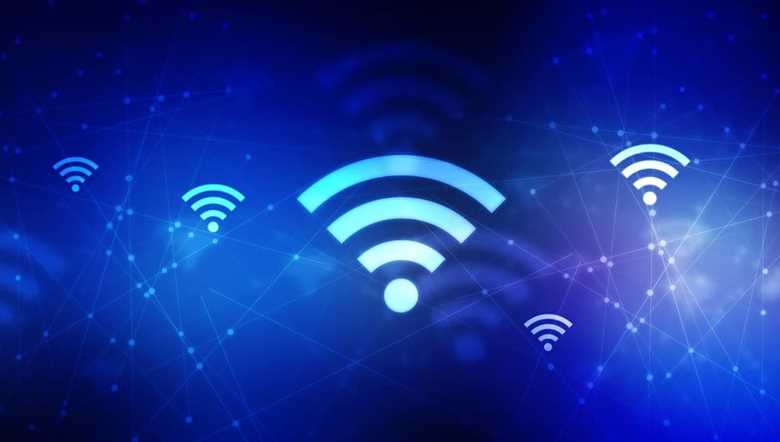Introduction
The increasing demand for higher data rates and reduced latency continues to drive cellular communication evolution and transmission. 5G promises to take performance to levels never seen before, with mounting pressure to deploy 5G handsets faster than any previous cellular standard.
With this urgency to release 5G smartphones, potential Wi-Fi coexistence issues have largely been ignored, even though Wi-Fi and 5G cellular are complementary technologies.
Wi-Fi and cellular technology continue to advance almost in parallel to each other in the form of Wi-Fi 6 and 5G, both of which share a number of advanced features, resulting in more options, and therefore, more flexibility when it comes to connecting an enterprise and its
assets. With flexibility, however, comes complexity, and many enterprises are left wondering what the best solution to meet their specific needs.
5G and Wi-Fi Features
There are many features both technologies are sharing as below:
- Multi-User MIMO (MU-MIMO)
One of the important features that 5G and Wi-Fi 6 share is an improved version Multi-User MIMO (MU-MIMO) that lets devices respond to the wireless access point at the same time and allows the access point to talk to multiple devices at once, and beamforming for improved signal power, which results in significantly higher rates at a given range. - Orthogonal Frequency Division Multiple Access (OFDMA)
Both technologies also make use of the channel access method Orthogonal Frequency Division Multiple Access (OFDMA), which allows for the division of a wireless channel into a large number of sub-channels, with each one carrying data intended for a different device. - High Order Modulation
Another shared feature, 1024 quadrature amplitude modulation mode (1024-QAM), enables throughput increases for Wi-Fi 6 by as much
as 25% over Wi-Fi 5, and in the case of 5G, this feature was part of 3GPP Release 15, and it allows 5G to achieve higher peak data rates and spectral efficiency in favorable scenarios.
Wi-Fi Coexistence with 5G
Combined with 5G’s high speeds, efficient use of both Wi-Fi and 5G spectrums could offer substantially increased data rates with negligible latency. Wi-Fi thus must remain an integral part of smartphones, complementing 5G to optimize the user experience.
The 5-GHz Wi-Fi channel (802.11a/n/ac/ax) is being widely implemented in the user equipment (UE) across the world, offering additional range beyond the traditional 2.4-GHz spectrum.
Combined with the high speeds available in 5G, the efficient utilization of both Wi-Fi and 5G spectrums has the potential to offer substantially increased data rates with negligible latency. Therefore, it’s vital that Wi-Fi remains an integral part of smartphones and complement 5G to provide the optimal user experience.
Interference Issues
Due to the proximity of cellular and Wi-Fi channels in 2.4- and 5-GHz spectrums, utilizing both Wi-Fi and New Radio (NR) spectrums can cause interference during operation. The 2.4-GHz Wi-Fi channel is adjacent to the n41, n40, and n7 spectrum, while the n79 band is adjacent to the 5-GHz Wi-Fi channel.

Mobility
5G — as cellular technology always has — offers a level of mobility that Wi-Fi doesn’t and Wi-Fi handover can be challenging in these situations whhereas LTE and 5G were built for that level of mobility.
What spectrum will you operate on?
One thing to think about when designing an indoor network is the fact that Wi-Fi and cellular traditionally operate on different spectrum, with the most significant difference being that Wi-Fi makes use of unlicensed spectrum, while cellular is on licensed spectrum, making this a fundamental topic when comparing the two.
There are stricter rules in the licensed spaced, while on the other hand, unlicensed spectrum is more like a sandbox where users can do, within reason,
what they want.
Wi-Fi 6, just like the version before it, will continue to use exclusively unlicensed spectrum. However, in addition to the 5 GHz band that was
used for Wi-Fi 5, Wi-Fi 6 will also use the 2.4 GHz band. Wi-Fi 6 also continues to operate in the 60GHz band and the 900 MHz which offers longer range and lower power connectivity for low bandwidth IoT applications.
The 60GHz band, in the millimeter wave region of spectrum, is well suited to deliver multigigabit speeds, but due to limited propagation, distance is shorter than the other frequencies in this standard. The use of these bands is also unique to Wi-Fi 6 and previous Wi-Fi versions. Further, the development of WiFi 6E delivered an additional 1020 megahertz of spectrum in the 6 GHz band, which, again, is unlicensed.
Mobile cellular networks, on the other hand, have historically always operated on licensed spectrum. When it comes to 5G, specifically, it might be true that major U.S. carriers have different spectrum portfolios made up of high-, mid- and low-band spectrum, but they are all still making use of only licensed spectrum, with the exception of Licensed Assisted Access where operators aggregate unlicensed 5 GHz with licensed spectrum.
Conclusion
One way to think about the coexistence of Wi-Fi and 5G on a network is at the physical level where the two technologies are using the
same bands. The key here is for each technology to “play nicely together” and effectively stay out of each other’s way.
In the future, you won’t have to choose between the two, as 5G and Wi-Fi 6 will form a complementary relationship. The technologies are built from the same foundation and will work together to support different things. What this means is the ability to connect even more devices, creating benefits for mission-critical IoT devices in manufacturing, healthcare, energy, and more. This also means we will get to enjoy more immersive applications like VR and augmented reality networks.
5G is able to pick up in areas where Wi-Fi 6 can’t reach—for example, when IoT devices move outside of an indoor space, a sensor can still connect via 5G.
References
- RCRWireless.com
- techrepublic.com
- Wi-Fi, public 5G or private network,White Paper.
- electronicdesign.com
- Cisco.com













